
Thanksgiving for Birds
November 19, 2006
| As the weather chills and it stays dry, the winter migrants and year 'rounders congregate at the water and feeding stations. This past week, the first fox sparrow and savannah sparrows showed up for their pictures, along with a covey of very nervous bobwhite quail. | |
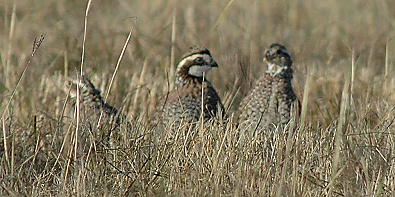 |
|
| Quail moving across the meadow are just about invisible until--worried about the great eye of the lens--they stick their heads up to see if they should panic. These are moving from the trees and scrub along the west side of the meadow to the brushpile, where I put out corn. | |
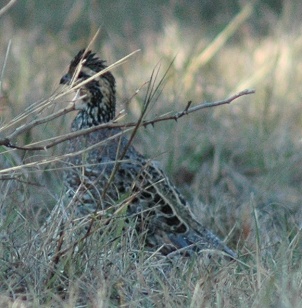 |
|
| A few days later, I spooked quail who were basking in the sun just inside the brushpile; one male flew away, but the rest of the covey stayed put until he called them out...and again, they scuttled rapidly across the more open ground, one by one, but sticking up their heads from time to time. | |
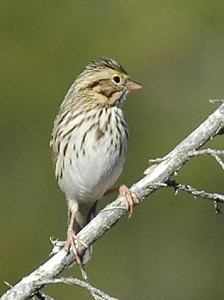 |
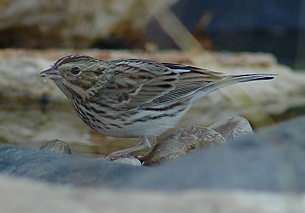 |
| When this sparrow lit on the brushpile, I knew it was one I hadn't photographed before--this year, anyway. The breast streaks are lighter and thinner than on the song sparrow, and the "whiskers" or "mustache" beside the throat aren't as broad (not visible in this shot.) There are a lot of sparrows I still don't know (the better camera continues to be a help there) and savannah sparrows are highly variable, so it took some time with Sibley that night to be sure this was a savannah. The yellowish color of the streak above the eye and near the beak is one of the big clues. | Closer, coming in to drink, the details of its markings are clearer, and the yellowish tinge shows even in the shade. |
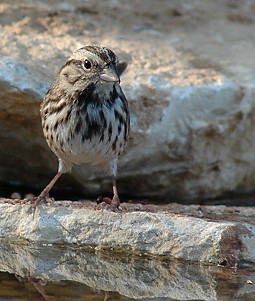 |
|
| For comparison, here's a song sparrow come to drink...the stripes are wider and darker, and there's no yellow on the head at all. Another reason I like this shot is the reflection of the rock in the water. | |
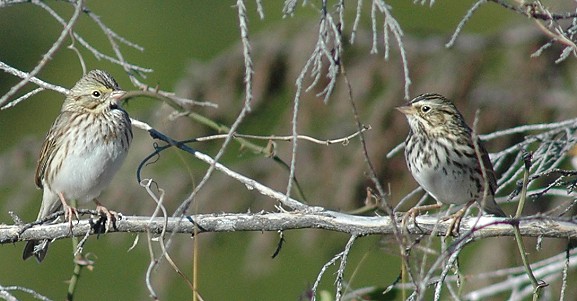 |
|
| And here are a savannah and a song sparrow sitting on the same branch of the brushpile, side by side, both fluffed up a little from the chill breeze. | |
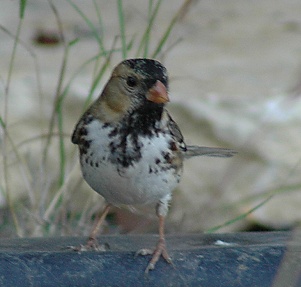 |
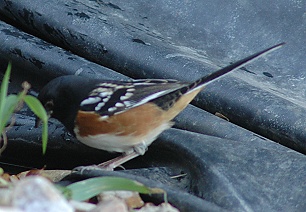 |
| Although Sibley comments in his book on bird behavior that Harris's sparrows are bolder than white-crowned sparrows, typically feeding farther from cover, that's not been true here. Harris's follow other birds to water or food, staying close to cover and diving back into it quickly. This is the first good shot I've gotten of one, and I tried many times yesterday. They are such handsome birds--I wish they'd behave the way Sibley describes and come on out into the open for me. | Also shy is the spotted towhee. We hear them calling from deep cover, and hear their vigorous scratching in the leaf litter, but they come to water, or to feed in the open, only near dusk. When we finally get all the rockwork done around the artificial spring, they (and other birds with a lot of black, such as the male orchard oriole) should show up better...but they'll still be shy. |
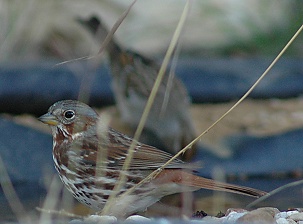 |
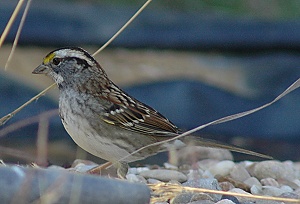 |
| This is the first fox sparrow of the season, earlier than I usually see one. They prefer the woods, and came up to Fox Pavilion only when the creek was completely dry. With water now near the woods, I don't expect to see one up at Fox again. I really like these guys with their size, their bold stripes, and their very different posture...you can tell a fox sparrow from a distance just by that. Unlike the other sparrows, they don't come in flocks...I've never seen more than one at a time. Clearly I need to trim the grass between my photo-place and the "creek" again, though. | The white-throated sparrow and the white crowned sparrow both show heads boldly striped in black and white. Both species also have individuals whose head stripes are brown and cream. But the white-throated looks browner, and "rounder" than the white-crowned, and has that little spot of sulphur yellow just in front of the eyes, which shows up well in this shot. In our experience, white-throated sparrows prefer the woods (they do forage up on the brushy knoll, though) and are shyer, but often do hang out with white-crowned. |
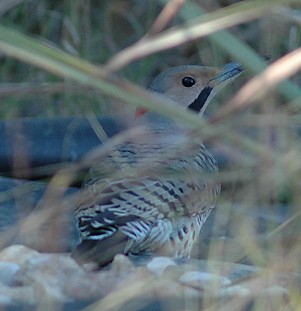 |
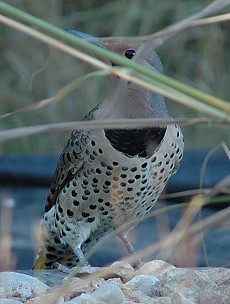 |
| Flickers, like other woodpeckers, come to water very quietly and are wary while there. This one approached from the cedar on the far side of Owl Water, and then positioned itself behind a screen of Indiangrass leaves where it could keep an eye on me. This was the closest I'd been to one with the big lens, so I took pictures anyway. This shows the back pattern, the bit of red on the back of the head, and the black "whisker" stripe on the side, but not the white rump-patch that's so obvious when a flicker flies away from you. | Here, the flicker is facing me, showing off the black collar and the beautiful spots on its breast...it's still watching me warily, its bill lined up with the grass stalk slanting across the picture. |
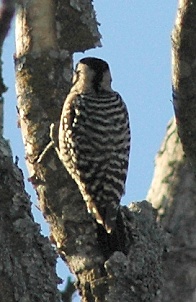 |
|
| As the sun sank, we heard a faint tap-tap-tapping from the dead tree on the west fenceline. Several cedar waxwings were in the tree, but they don't drill into wood. I finally spotted the tapper: a female ladderback woodpecker, high up and backlit by the sun. This shot required a little histogram adjustment in the computer. | |
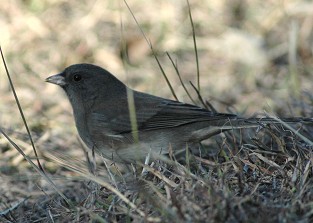 |
|
| Juncos are in the same family as sparrows and behave much like them--they eat seeds, they hop instead of walking, etc. This is the first I've ever photographed, and it may be the first I've seen (the only other record I have is from February 2001, a quick sighting on a misty day, and might have been a different bird.) This bird just made it into the week's page, by showing up Saturday afternoon, within about 10-15 feet of me. | |
![]()

